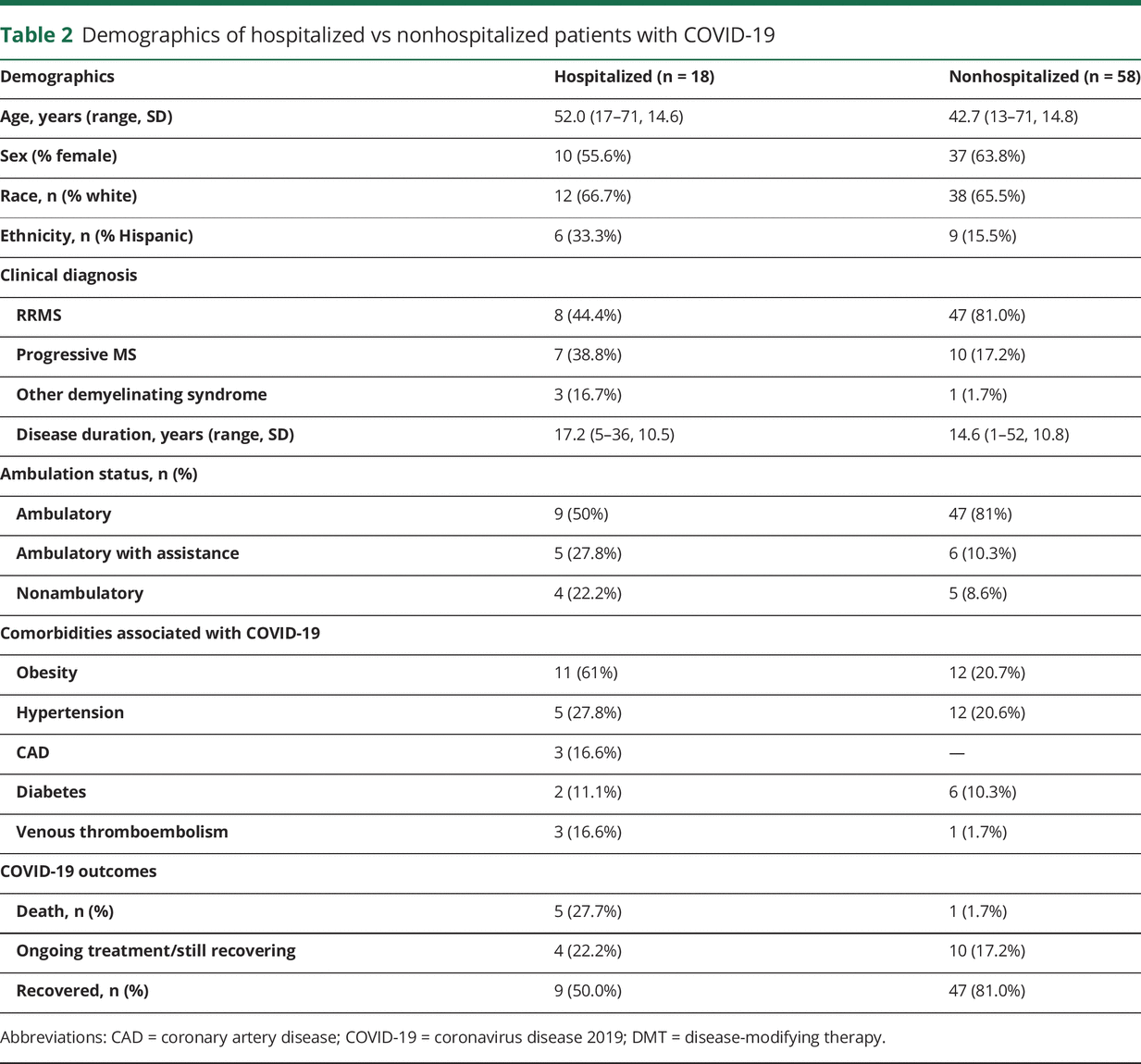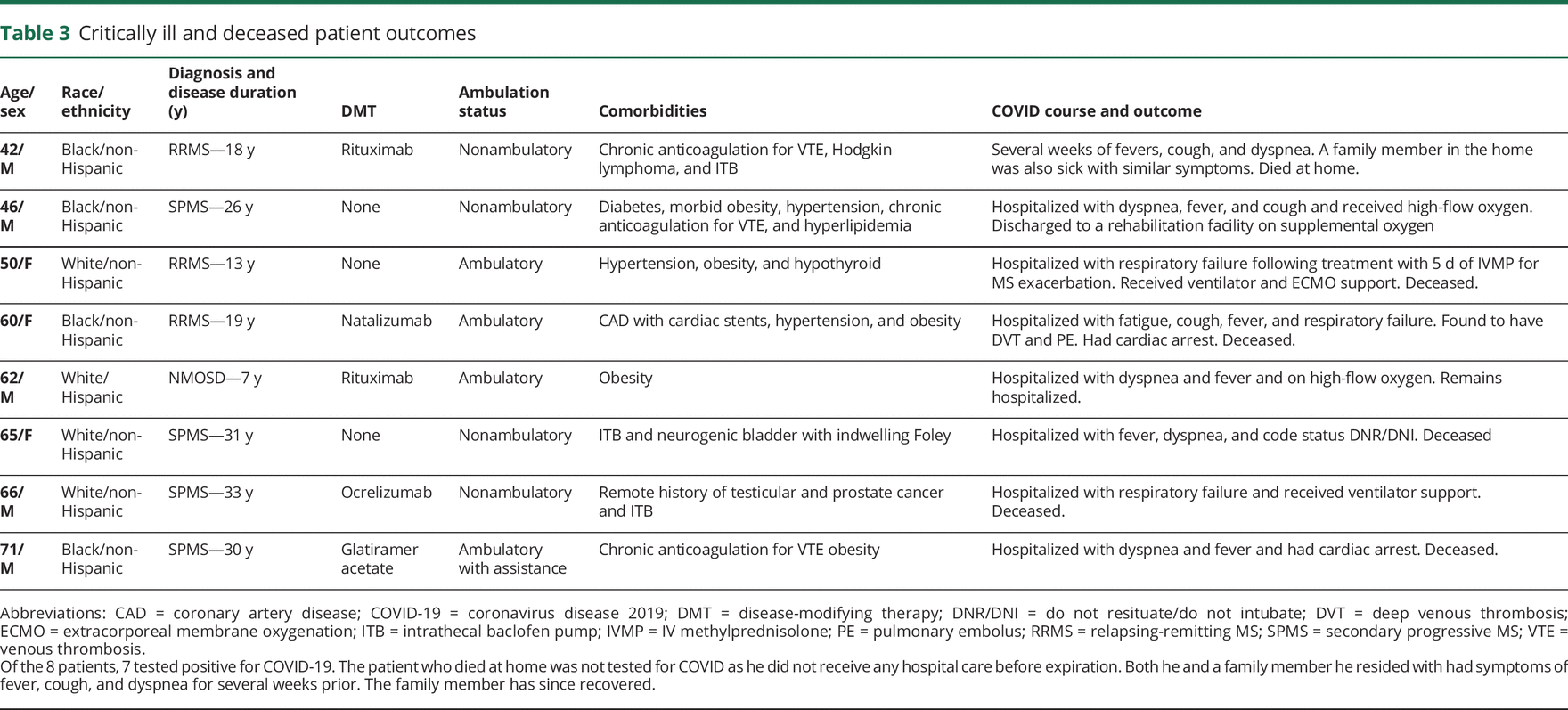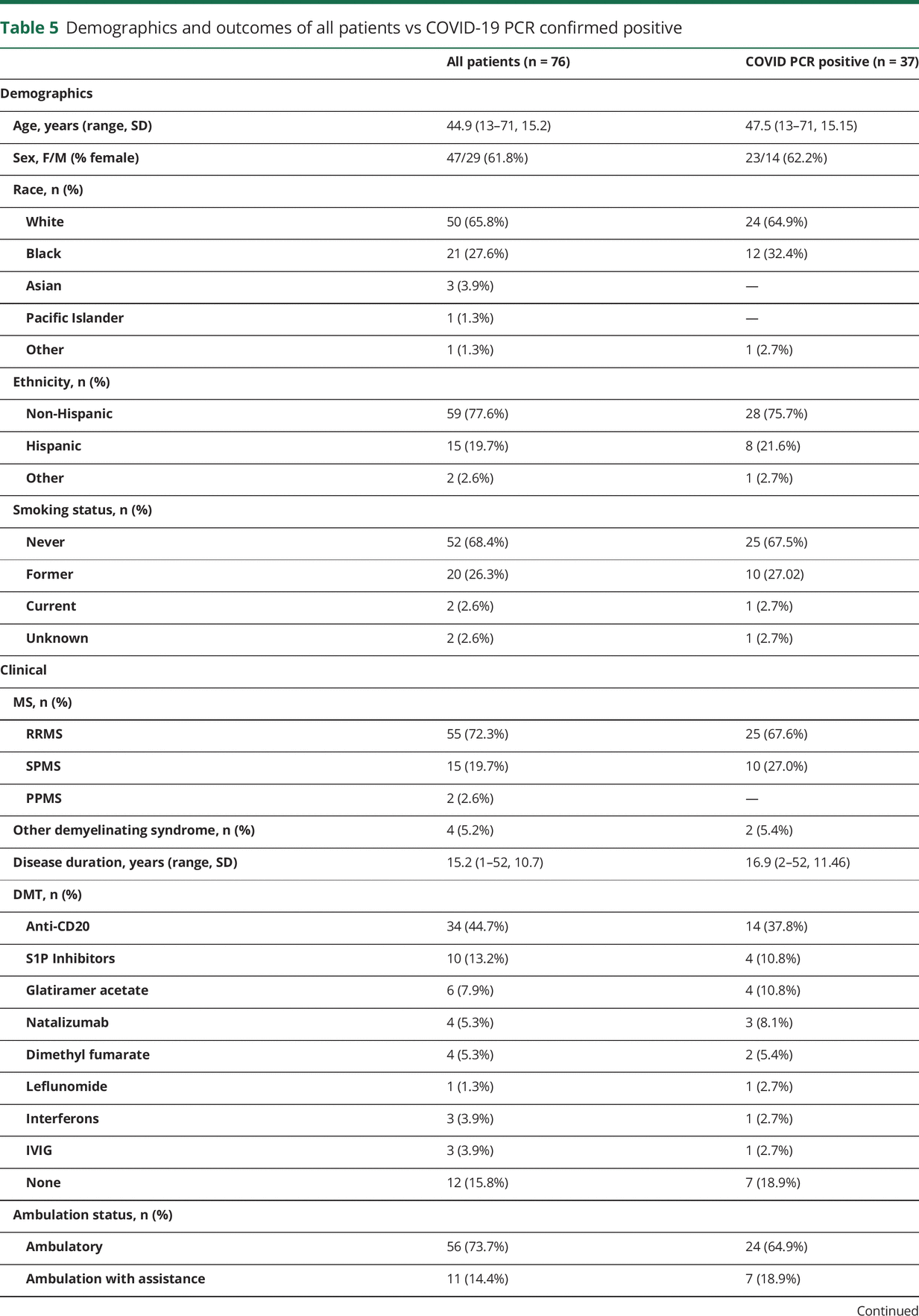COVID-19 outcomes in MS
Why is this study important?
Since the coronavirus disease 2019 (COVID-19) pandemic became a global public health crisis, individuals with chronic diseases have emerged as a group that is particularly vulnerable to developing severe, potentially fatal complications related to COVID-19 infection. If you are living with multiple sclerosis (MS) or a related disorder, you may worry that your condition may put you at higher risk of becoming infected with COVID-19 and of experiencing a more severe course of illness. People with MS who are treated with medications with immunosuppressive effects (disease-modifying therapies, or DMTs) may also worry about their ability to fight the infection effectively.
While precautions such as social isolation play an important role in minimizing the risk of getting infected, for people with MS, these may lead to missed appointments with their health care providers, which could make it harder to manage MS effectively.
How did the authors study this issue?
In early 2020, clinicians at a specialized center for treatment of MS in New York recognized that people with MS needed reliable information and guidance amid a pandemic that increasingly affected their community. They studied the health records of individuals with MS treated at several clinics in the greater New York area who received a diagnosis of COVID-19 disease between March 16 and April 30, 2020, to determine whether risk factors specific to MS influence COVID-19 outcomes.
The diagnosis of COVID-19 was made based on symptoms, course of illness, x-ray findings consistent with the infection, or a positive COVID-19 test result. The study, published in September 2020, ultimately included 76 individuals with MS or related disorders with laboratory-confirmed or suspected COVID-19 infection. A majority of those individuals (84%) were treated with DMTs.
Is MS a risk factor for severe COVID-19 disease?
Of the 76 people included in the study, 18 (23.7%) were hospitalized and 8 (10.5%) experienced COVID-19 critical illness or died as a result of the infection. The findings showed that the course of COVID-19 illness, the outcomes, and the risk factors for complications in people with MS were similar to those observed in the general population. DMTs did not appear to have an impact on the course or severity of COVID-19 disease.
However, the authors noted that these findings reflected their experience with COVID-19 disease in a small group of individuals with MS and should be further explored in a larger group of people with MS who contracted COVID-19. The sample included in the study consisted mostly of symptomatic individuals who were hospitalized and those who scheduled health care visits with their providers. Residents of nursing homes, who may visit specialized health care centers less often, were likely underrepresented.
While living with MS or being treated for this condition did not increase the risk for severe disease or death related to COVID-19 infection, the authors did identify certain risk features that were common among people who were hospitalized for COVID-19 infection or had severe illness or death related to COVID-19. These included being older and living with other diseases (obesity, diabetes, high blood pressure, or heart disease), but also MS-specific features such as non-ambulatory status and progressive course of MS. Such risk factors might make people with MS more vulnerable to becoming seriously ill if they are exposed to COVID-19.
As the COVID-19 outbreak continues to affect people of all ages, regardless of their health status, it is important to seek guidance from your health care provider about infection prevention, treatment, and management of MS during these challenging times.
Original Article
COVID-19 outcomes in MS
Observational study of early experience from NYU Multiple Sclerosis Comprehensive Care Center
Neurology Neuroimmunology & Neuroinflammation
Erica Parrotta, View ORCID ProfileIlya Kister, Leigh Charvet, Carrie Sammarco, Valerie Saha, Robert Erik Charlson, Jonathan Howard, Josef Maxwell Gutman, Malcolm Gottesman, Nada Abou-Fayssal, Robyn Wolintz, Marshall Keilson, Cristina Fernandez-Carbonell, Lauren B. Krupp, Lana Zhovtis Ryerson
Abstract
Objective To report outcomes on patients with multiple sclerosis (MS) and related disorders with coronavirus disease 2019 (COVID-19) illness.
Methods From March 16 to April 30, 2020, patients with MS or related disorders at NYU Langone MS Comprehensive Care Center were identified with laboratory-confirmed or suspected COVID-19. The diagnosis was established using a standardized questionnaire or by review of in-patient hospital records.
Results We identified 76 patients (55 with relapsing MS, of which 9 had pediatric onset; 17 with progressive MS; and 4 with related disorders). Thirty-seven underwent PCR testing and were confirmed positive. Of the entire group, 64 (84%) patients were on disease-modifying therapy (DMT) including anti-CD20 therapies (n = 34, 44.7%) and sphingosine-1-phosphate receptor modulators (n = 10, 13.5%). The most common COVID-19 symptoms were fever and cough, but 21.1% of patients had neurologic symptom recrudescence preceding or coinciding with the infection. A total of 18 (23.7%) were hospitalized; 8 (10.5%) had COVID-19 critical illness or related death. Features more common among those hospitalized or with critical illness or death were older age, presence of comorbidities, progressive disease, and a nonambulatory status. No DMT class was associated with an increased risk of hospitalization or fatal outcome.
Conclusions Most patients with MS with COVID-19 do not require hospitalization despite being on DMTs. Factors associated with critical illness were similar to the general at-risk patient population. DMT use did not emerge as a predictor of poor COVID-19 outcome in this preliminary sample.
Glossary
CAD= coronary artery disease; COVID-19= coronavirus disease 2019; DMT= disease-modifying therapy; ICU= intensive care unit
At present, we do not know whether multiple sclerosis (MS) or disease-modifying therapies (DMTs) for MS increase the risk of acquiring coronavirus disease 2019 (COVID-19) or worsen the course (hospitalizations, intensive care unit [ICU], and death). DMT medications have immunosuppressive effects that could hamper mounting an effective immune response to the infection.1 On the other hand, immunosuppression could offer protection by downregulating hyperinflammation and the cytokine storm associated with COVID-19.2
New York City emerged as the epicenter of the COVID-19 pandemic in the United States in March 2020. Given the widespread prevalence of COVID-19 in our community, clinicians at the NYU Multiple Sclerosis Comprehensive Care Center (MSCCC) received numerous reports of Severe Acute Respiratory Syndrome Coronavirus 2 (SARS-COV2) infection from patients and began systematically collecting symptom data and the clinical course. This timely, real-world observational study on outcomes of COVID-19 in actively treated patients with MS help inform clinicians as they counsel patients with MS and guide treatment decisions during the pandemic.
Methods
For this observational study, demographic and clinical features were collected on patients currently followed at MSCCC and its 4 affiliated sites in the greater New York area (2 in Long Island and 2 in Brooklyn) with a history of COVID-19 from March 16 through April 30, 2020. All patients who contacted the center with infectious symptoms or were seen during routine teleneurology visits were queried regarding COVID-19 exposure using a standardized instrument. Inclusion criteria were any patient with MS or related disorders who was diagnosed with COVID-19 by a health care provider (based on symptoms, course, radiographic findings consistent with CDC COVID-19 criteria,3 and/or positive SARS-COV2 PCR when available). For hospitalized patients, in-patient records were reviewed. NYU School of Medicine Institutional Review Board approval was obtained for the study.
Descriptive statistics were used to summarize the demographic and clinical characteristics of patient. Continuous variables were described in terms of means and SDs, and categorical variables were summarized as counts and percentages. No imputation was made for missing data. Differences between hospitalized vs nonhospitalized patients were compared by the t test, χ2 test, or Fisher exact test as indicated, with CIs set at 95%.
Data availability
Anonymized data can be made available on request for research purposes by submitting a request to the corresponding author. No deidentified patient data or study-related documents will be shared.
Results
A total of 76 patients met the inclusion criteria, 72 (93%) with MS, and 4 (7%) with related disorders (neuromyelitis optica spectrum disorder, chronic relapsing inflammatory optic neuropathy, neurosarcoidosis, and myelin oligodendrocyte glycoprotein-immunoglobulin G–associated disorder). The average age of the full sample was 44.9 ± 15.2 years (range 13–71 years), and 61.8% were female. The disease duration was 15.2 ± 10.7 years (range 1–52 years). Racial breakdown was 50 (65.8%) white, 21 (27.6%) black, 3 (3.9%) Asian, 1 (1.3%) Pacific Islander, and 1 (1.3%) other. Hispanic ethnicity was reported by 15 (19.7%). Of the 72 patients with MS, 55 (76.4%) had a relapsing-remitting subtype and 17 (23.6%) primary or secondary progressive subtypes. Sixty-five patients (84%) were on DMT. One patient resided in a nursing facility. He had an uncomplicated course.
Common symptoms reported included fever (68.4%), cough (68.4%), fatigue (38.2%), shortness of breath (31.6%), and myalgias/arthralgias (26.3%). Other frequent symptoms included anosmia (22%), ageusia (19.7%), and headache (21.1%). A subset reported neurologic symptom recrudescence (21.1%) suggestive of relapse. In some cases, neurologic symptoms preceded viral symptoms by several days.
Of the 84% of patients on DMTs, 44.7% were treated with anti-CD20 therapies (rituximab n = 18; ocrelizumab n = 16), 13.5% on sphingosine-1-phosphate (S1P) modulators (fingolimod n = 8; siponimod n = 2), 7.9% (n = 6) on glatiramer acetate, 5.3% (n = 4) each on natalizumab and dimethyl fumarate, and 3.9% (n = 3) on beta-interferons. Table 1 summarizes outcomes by DMT class. There were no observed differences between DMT use among those who were and were not hospitalized or between those specifically treated with anti-CD20 therapies (43% vs 50%, OR = 0.76 [CI 0.26–2.18]).

As shown in table 2, of the full sample, 18 (23.7%) were hospitalized. The hospitalized vs nonhospitalized patients were more likely to be older (CI 1.22–17.11, p = 0.03), have progressive MS subtype (OR 4.11 [CI 1.21–13.97], p = 0.04), required ambulatory assistance or were nonambulatory (OR 4.27 [CI 1.38–13.27], p = 0.01), and have comorbid obesity (OR 6.25 [CI 1.90–20.50], p = 0.003). Coronary artery disease (CAD) was observed in n = 3 hospitalized patients and no cases in nonhospitalized patients. History of venous thromboembolism was recorded in n = 3 hospitalized and n = 1 nonhospitalized patient.

Eight patients (10.5%) had critical illness defined by ICU admission (n = 5) and/or death (n = 6) (table 3). Compared with the entire MS sample, the critically ill patients were older (mean of 57.7 ± 10.5 years, range 42–71 years), more likely to have a progressive subtype (50.0%), and or required assistance for ambulation/nonambulatory (62.5% requiring assistance or nonambulatory). Following the pattern observed in those who were hospitalized, the critically ill group had had high rates of comorbid obesity (62.5%), CAD (25%), and venous thromboembolism (37.5%). There were no reports of stroke. One patient had hypercoagulability resulting in multiple venous thromboembolisms and ultimately died.
 Nine patients with pediatric-onset MS were identified as the center has a large pediatric MS sample (table 4). Ages ranged from 13 to 26 years; 8 were female, and all had relapsing-remitting MS. Noted comorbidities were obesity (n = 3), type I diabetes (n = 1), or both (n = 1). Two of the 9 were hospitalized requiring supplemental oxygen. None required invasive ventilation. Eight patients were either fully recovered or recovering at censoring date. One remains hospitalized.
Nine patients with pediatric-onset MS were identified as the center has a large pediatric MS sample (table 4). Ages ranged from 13 to 26 years; 8 were female, and all had relapsing-remitting MS. Noted comorbidities were obesity (n = 3), type I diabetes (n = 1), or both (n = 1). Two of the 9 were hospitalized requiring supplemental oxygen. None required invasive ventilation. Eight patients were either fully recovered or recovering at censoring date. One remains hospitalized.

Discussion
Patients with MS and related disorders often seek guidance regarding the impact of the disease and medication on their risk of COVID-19. This observational study—although subject to sampling and ascertainment biases—provides some insights regarding COVID-19 disease course in actively treated patients with MS and related disorders.
The rate of hospitalization in our patients (24%) and mortality (7.9%) are in line with the data of another published MS patient survey4 and for the general population of patients with COVID-19.5 Similar risk factors were identified including older age, male sex, and high number of comorbidities such as obesity, diabetes, hypertension, and CAD.6,–,8 MS-specific features associated with more severe COVID-19 included nonambulatory status and progressive disease course. Given the small sample size, we could not determine whether these patients were at higher risk, given their advanced age and other comorbidities, or whether worse disability in and of itself represents an additional risk factor.
We did not observe an association between DMT class and COVID-19 outcome in univariate comparisons; however, our sample size is small, and these preliminary findings should be interpreted with caution. There is a relatively high proportion of COVID-19–infected patients on anti-CD20 therapies (44.7%) compared with our MSCCC population in which 33.1% of patients take anti-CD20 therapies. This observation could be an artifact of sampling bias or might represent an increased susceptibility to COVID-19 infection as anti-CD-20 therapies increase the risk of non-COVID-19 infections in general.1 It is worth noting that although we had a larger-than-expected portion of patients on anti-CD20 therapies, there is no evidence to suggest worse outcomes.
As a note of caution in the care of patients with MS, a subgroup of individuals reported worsening of preexisting neurologic symptoms before or at onset of COVID-19 symptoms. One such patient was treated with several days of high-dose steroids after which they presented with respiratory and circulatory failure and ultimately died (table 3). Infections are a well-known cause of pseudoexacerbations, and in areas with high prevalence of COVID-19, testing for SARS-COV2 should be considered in patients with acute worsening of preexisting symptoms before steroid treatment is initiated.
Our study has several limitations. This was a convenience sample and not randomly selected, nor was the entire practice systematically surveyed. Patients were identified during routine teleneurology visits, if they notified the office, or if hospitalized—likely leading to an overrepresentation of more symptomatic individuals. Patients on higher potency infusible DMTs were more likely to have frequent follow-up and may have been more readily captured. In contrast, patients in nursing homes, who would be expected to be most severely affected by COVID-19, visit specialized centers less frequently and could be underrepresented in our cohort. Although we used a systematic questionnaire to collect relevant data, we could not verify these data independently unless the patient was seen by an NYU Langone-affiliated physician or hospital. Another problem was lack of access to COVID-19 testing in our area. Less than half of our patients (48.7%) underwent SARS-COV2 PCR testing. As shown in table 5, subgroup analysis showed that this group was not different from the overall sample with respect to demographic or MS-related features.

Our early experience with COVID-19 at NYU Langone MSCCC could inform clinicians taking care of patients with MS during the pandemic. Our findings suggest that individuals with MS who experience COVID-19 have similar disease course, outcomes, and risk factors for complications as the general population. Rigorous, population-based studies are needed to confirm our preliminary findings and better define the risk of COVID-19 infection with respect to individual DMTs. Future studies should assess the role of baseline lymphocyte counts and immunoglobulin levels with respect to viral susceptibility and course as well as examine the frequency of serologies to COVID-19 according to DMT class. As we and others collect more data and contribute to larger MS registries, we expect more answers will be forthcoming to further guide patient management.
Study funding
No targeted funding reported.
Disclosure
E. Parrotta reports no disclosures. I. Kister served on advisory boards for Biogen and Genentech and received consulting fees from Roche and research support for investigator-initiated grants from Sanofi Genzyme, Biogen, EMD Serono, National MS Society, and the Guthy-Jackson Charitable Foundation. L. Charvet reports no disclosures. C. Sammarco receives consulting compensation from Biogen and Genentech. V. Saha, R.E. Charlson, J. Howard, J.M. Gutman, M. Gottesman, N. Abou-Fayssal, R. Wolintz, M. Keilson, and C. Fernandez-Carbonell report no disclosures. L.B. Krupp has received advisory board/consulting fees, travel and meal allowances, and/or research funding from Sanofi Aventis, Biogen, Novartis, Gerson Lehrman, EMD Serono, Allergan Inc., and Tesaro Inc. She is also a noncompensated consultant and/or advisory board member with Novartis and Celgene and receives royalties for use of the Fatigue Severity Scale by various biopharmaceutical entities. L. Zhovtis Ryerson received personal compensation for advisory board participation for Biogen and received research support from Biogen. Go to Neurology.org/NN for full disclosures.
